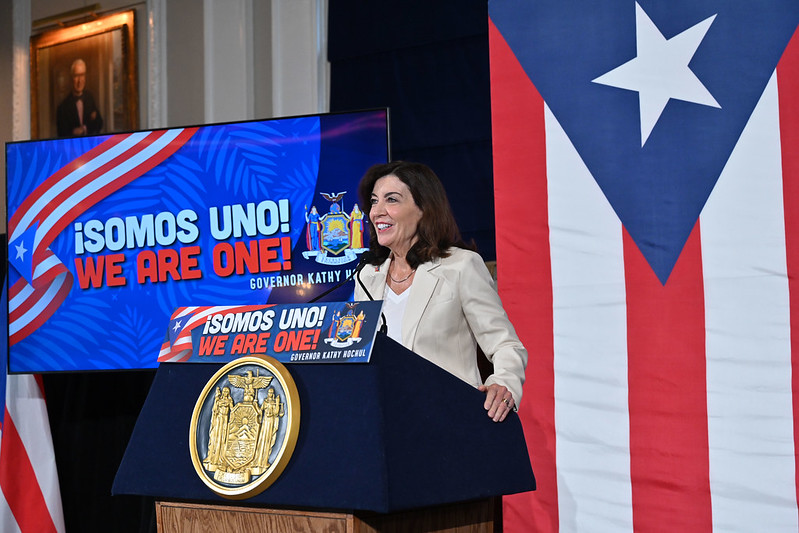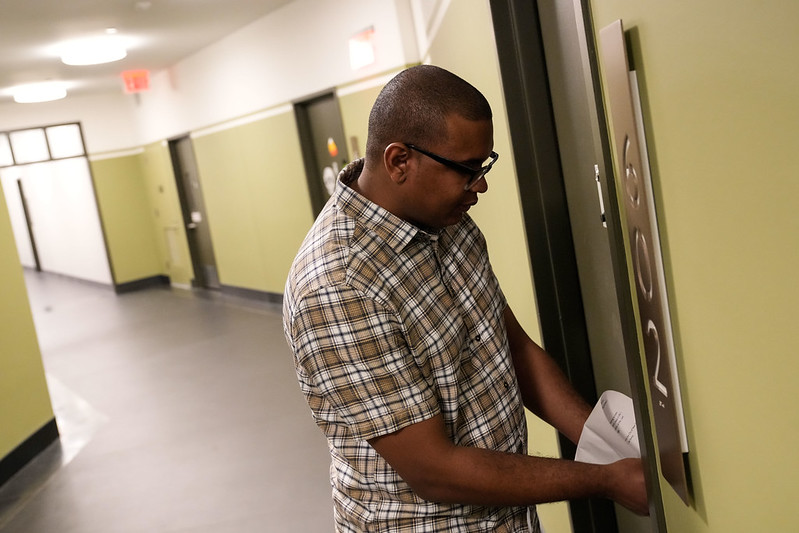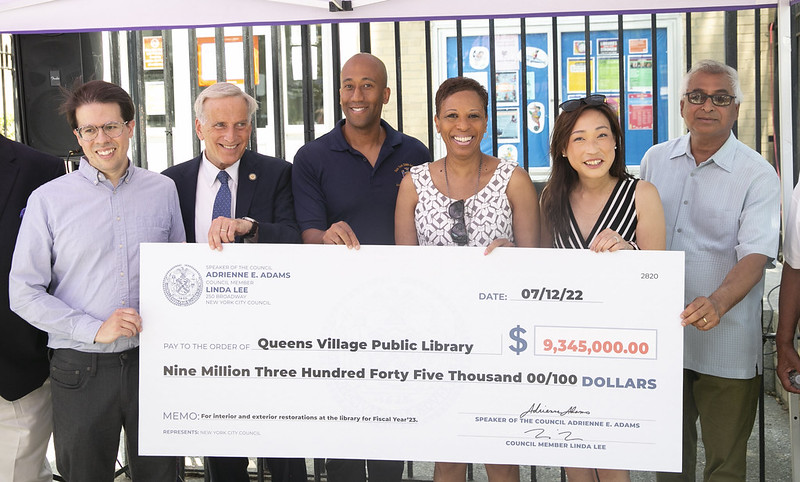A Closer Look at 2022 Gubernatorial Election Results Shows Why New York Democrats Must Pay Better Attention to Latino Voters

Gov. Hochul (photo: Kevin P. Coughlin/Office of Governor Kathy Hochul)
How several hundred Latino-majority election districts voted in the 2022 gubernatorial race between Democratic Governor Kathy Hochul and Republican Congressional Representative Lee Zeldin should prompt Democrats to pay more attention to Latino voters’ needs.
Perhaps the biggest finding is that Latinos—traditionally among the most loyal Democrats in the state—moved toward the Republican candidate. Though the movement is not large enough for Democrats to be alarmed, unless Democrats engage and invest resources in Latinos now, they can potentially see a much larger defection among Latinos.
Key findings of my new analysis of voter data by election district include:
-Turnout in 2022 increased by over 200,000 votes statewide compared to the previous gubernatorial general election in 2018, when Democratic Governor Andrew Cuomo fended off Republican County Executive Marc Molinaro’s challenge.
-Despite this statewide increase, New York City saw a 15% decline in voting participation (from over 2 million voters to just under 1.8 million). By contrast, many counties outside the city, like Nassau, Suffolk, and Erie, saw increases in voting participation compared to the previous gubernatorial election. The largest increase was seen in Erie, Governor Hochul’s home county.
-Statewide, Latino voting participation declined 19% from 2018 to 2022, with just under half-a-million Latinos going to the polls in 2022 (Estimates are based on my analysis of election results and the use of demographic modeling data.)
-The largest decline in Latino voting participation across overall was in New York City. Only 285,176 Latino voters cast a ballot, a 28% decline from 2018.
-Of the 285,000+ Latino voters who voted in New York City in 2022, 50% were registered Democrats compared to almost 60% in 2018, an almost 10% decline in voting participation among Latino Democrats in the city.
-Latino support in New York City for the top of the Democratic ticket declined by over 10% from 2018 to 2022. In majority Latino election districts across the city in 2018, support for Cuomo was 90-95%. Support for Molinaro registered below 5% in most of those districts. In 2022, support for Hochul in the same areas hovered between 78% and 82%. Roughly 20% of Latinos in these areas supported Zeldin.
What can we conclude from all this?
Latinos continue to support Democrats in large though decreasing numbers.
From 2018 to 2022 there was a significant decline in Latino voting participation in New York City, and an increase in Latino support for the Republican candidate for governor.
Yet that increase hardly signals a game-changing political shift in New York. We will need to wait until the 2024 election cycle for more clues about Latino voters’ participation and their party preference. We may see some indications via the 2023 New York City Council elections and public polling ahead of the real evidence in the 2024 elections.
So what factors prompt both a decline in voting participation and seemingly increased support for Republicans?
While the reasons behind this decline are complex, we do know that low voter turnout among Latinos is in part a direct result of lack of investment in and engagement of Latino voters.
Bernard Fraga, in his excellent data-driven book, The Turnout Gap, has observed that when political parties and candidates fail to engage Latinos, turnout lags. But intentional and strategic engagement efforts, tackling critical policy issues that affect Latino communities, and investing in the political empowerment of Latinos through the support and training of Latino candidates all remind Latinos of their value and importance in the political/electoral sphere.
Factors that led to a 28% decline in Latino voting participation in New York City include the Hochul campaign and the State Democratic Party relying on surrogates and TV and radio ads. This tactic does not work for Latinos, who respond better to personal contact and sustained engagement. In short, it is the bread-and-butter grassroots approach to campaigning that Latinos respond to more favorably, and which Hochul and the state party failed to do. Furthermore, a six-figure sum was a paltry investment in the State Democratic Party’s Nueva York Initiative—purportedly an effort to woo Latinos to the party of which Hochul is the de facto leader.
Back just before the 2022 general election, I warned, “She may win [Latinos’] vote, but it’ll likely be with a smaller margin than that of any of her Democratic predecessors.” This is exactly what transpired.
The shifts we are seeing in Latino voter preference are not significant enough to conclude that Latinos are on the verge of initiating a Republican wave, though some of the shifts could make the difference in select local races like for the State Legislature or City Council. But something is happening and our leaders need to pay attention.
Many Latinos feel that Democrats are abandoning them on issues like jobs, public safety, education, and affordable housing, and in terms of their presence in our communities. In the 2024 election cycle, will we see widespread Latino defection from the Democratic Party? Or will we finally see political parties make a real investment in Latinos?
***
Eli Valentin is a political analyst and author of the forthcoming book, Reinhold Niebuhr: A Political Life. On Twitter @EliValentinNY.
***
Have an op-ed idea or submission for Gotham Gazette? Email This email address is being protected from spambots. You need JavaScript enabled to view it.
Applying a Model That’s Worked to Tackle Our Homelessness Crisis

Heading home (photo: Michael Appleton/Mayoral Photography Office)
Solving a worsening homelessness emergency can feel impossible, but New York City already knows how to do it—and did it as recently as 2015 with military veterans.
Now, with the overall crisis reaching levels not seen since the Great Depression, New York should celebrate its success ending chronic veteran homelessness, re-examine what worked with that initiative, and apply it to the broader crisis. After all, it is an effective, proven way to ensure that every New Yorker has access to the housing they deserve.
It is useful to recognize just how successful that initiative has been for the city’s unhoused veterans. Despite the many endemic challenges facing returning servicemen and women, which often include lingering physical and mental health challenges from their service as well as struggles with substance abuse, New York City reduced veteran street homelessness by more than 98% from 2011 to 2020.
That is a remarkable achievement that didn’t happen by accident. And the good news is that we can do it again. In fact, the wheels are already in motion.
The initiative worked so well because the entire government ecosystem, from Washington D.C. to City Hall, prioritized getting veterans off the street. That level of support was crucial: it offered providers like us a broad toolkit to tackle the problem and solve challenges for veterans with unique needs.
One notable tool is the Rapid Re-Housing model, which aligns with the “Housing First” philosophy.
This intervention is primarily concerned with providing short-term rental subsidies and housing placement services to minimize the time clients spend homeless and to transition them quickly into permanent housing. In other words, the model centers permanent housing as the ultimate policy solution—a simple approach, but one that feels ambitious in a city that heavily relies on lengthy stays in shelter to manage homelessness.
Programs grounded in the “Housing First” philosophy—programs that do not mandate shelter stays or acceptance of services as a precondition to housing—can be truly transformative. As the homeless shelter population in New York City reached record heights in 2022 and continues to grow, this lesson was applied in a new pilot program with Volunteers of America-Greater New York (VOA-GNY) called Street to Home, which adopts the same “Housing First” philosophy that loomed large in the efforts to end veteran homelessness. Since September 2022, the program has helped 66 people get off the street and into a permanent home.
One of the greatest challenges to ending the cycle of homelessness is that individuals experiencing homelessness often cycle in and out of acute care facilities and have episodic encounters with mobile outreach and support services, but do not have the stable foundation of housing from which to rebuild their lives. The “Housing First” philosophy has been proven effective in ending chronic homelessness, also evident by its success with the veteran population, and is now helping more individuals experiencing homelessness access the services they need to get back on their feet through supportive housing.
But Rapid Re-Housing is not the only model that was central to the work of ending chronic veteran homelessness. That initiative showed the value of intervening at all points of the system, including before people even become homeless. Our Supportive Services for Veteran Families program provides prevention services to reach veterans at risk of homelessness and intervenes with an array of services, such as legal assistance and financial assistance, to prevent them from ever experiencing homelessness in the first place.
Unfortunately, there are limited resources available to expand the Rapid Re-Housing and prevention models beyond veterans, despite their proven track records. That should change, but it will require the same level of governmental support that was allocated to veterans—a population for whom there is significant political goodwill across party lines and levels of government.
While daunting, the veteran initiative is a proven model to emulate. The federal government stepped up and provided resources and funded new programs to reach veterans experiencing and at risk of homelessness. Now these programs should be scaled and made available to all. Everyone, across the government, non-profit, and private sectors should work together to provide our unhoused neighbors with the personalized, comprehensive care they deserve.
By following this model, New York can start to meaningfully address the homelessness crisis—just as it has done before.
***
Anddy Perdomo is Assistant Vice President, Veteran Services & Economic Empowerment Initiatives at Volunteers of America-Greater New York. On Twitter @VOAgny.
***
Have an op-ed idea or submission for Gotham Gazette? Email This email address is being protected from spambots. You need JavaScript enabled to view it.
New Yorkers Deserve a More Socially-Responsible Budget

Library funding in hand (photo: John McCarten/NYC Council Media Unit)
As the New York City budget cycle ramps up, the need for near-term fiscal balance often leads to decisions that are costly, economically and socially, in the long run. Put another way, it’s generally cheaper to help than to harm, but the budget process is geared toward the latter. The extent to which this is avoidable in reality is open to debate. However, New Yorkers, as citywide investors, should have a publicly available tool to shed light on how these outcomes are affecting the overall well-being of the city and its residents.
Due to the complexity of the budgeting process in New York City, gauging such information is, at best, rather difficult and time-consuming. Budgetary analysis can be found in various reports by city entities, notably the Comptroller’s Office and the Independent Budget Office (IBO), as well as those by agencies, the City Council, and nonprofit groups. The challenge as an outsider looking at these many materials is that they are often overly-complicated, incomplete, or issue-specific – requiring labor intensive research to better understand the bigger picture across the vast array of city services.
A public communications approach along the lines of socially responsible investing (SRI), a strategy that works to generate both social change and financial returns, would afford New Yorkers a better sense of whether or not their tax dollars are being put to best use. It represents a shift from the current outlook, which strives to limit negative outcomes, by giving a sense of how strategic investments could produce more positive ones. The more comprehensive, economically-centered, easy-to-follow, and transparent the information is, the better.
To note, this idea differs to some degree from earlier discussions about linking the Mayor’s Management Report (MMR) to the budgetary framework. And instead of auditing the government to root out misuse or ineffective use of funds, it would work to define how current fiscal decisions will play out more broadly.
It would expand upon the forecasting over a five-year period that the IBO already does for the proposed budget by offering alternative scenarios, with defined assumptions about either additional social investment or lack thereof. It could also offer analysis for more extended time periods.
The idea is a clearer focus on making the best choices and investments to do the most good, while expanding the city’s economy, over time.
There are many issues where the city’s budget is short-sighted, missing the opportunity to create economic benefits, as well as often-intertwined social gains. Although these issues are complicated on many levels, a few are provided for context. Being able to capture them in a more collective socio-economic picture would be the overarching goal.
One is the exorbitant amount New York City spends to incarcerate people. In fiscal year 2021, the annual cost per detainee in city jails exceeded $550,000 per year, approximately 34 times what the city directly spends annually per public school pupil. With an average daily detainee population of about 5,500 people at Rikers, that’s over $3 billion spent per year. Since employment – in and of itself – is connected to a lower likelihood of incarceration, it can help reduce the number of at-risk individuals that wind up in the criminal justice system in the first place, and should thus be made more of a focus for investment.
For example, shifting more of this funding toward vocational training programs at a two-year cost of somewhere between $3,500 (public) and $15,000 (private/non-profit) per person seems to be a much better investment. The clean energy sector specifically is an area in need of trained workers for economic growth. At the statewide level, this sector rebounded faster than nearly all others from 2020 to 2021, and about 90% of employers who were hiring in 2021 found the process to be either ‘somewhat difficult’ or ‘difficult.’
The housing crisis is another area where such return-on-investment calculations arise. The primary cause of homelessness is lack of affordable housing, particularly among families. For example, in fiscal year 2022, stays in the city Department of Homeless Services (DHS) shelter system stays were, on average, 509 days (single adults), 534 days (families with children), and 855 days (adult families). Among many negative outcomes, being homeless makes it harder to find and maintain employment and complete one’s education. The city spends billions of dollars per year on the shelter system.
While the city’s fiscal year 2022 budget did include about $5 billion more over ten years ($22 billion total) for affordable and public housing, that falls short of the city’s affordable housing needs. It is also less than the $4 billion per year ($40 billion over ten years) Mayor Adams pledged to spend during his campaign, which is based in part on estimates of what’s needed by pro-housing and anti-homelessness advocates.
Sufficient funding for education is critical to the overall health of the New York City economy. In the upcoming fiscal year, Mayor Adams is proposing to halt an expansion of preschool for 3-year-olds (3-K). There are many benefits for children who attend public 3-K. Some include a 6% increased likelihood of graduating from high school compared to peers who do not attend, as well as increased rates of taking the SAT and college enrollment. The administration is citing decreased enrollment, but should more closely evaluate outreach efforts.
Reduced city funding for CUNY is also on the table. This is again short-sightedly tied to decreased enrollment, which the city should work to reverse through outreach and investment. A 2020 study found that six out of seven of CUNY’s community colleges (which receive half of their capital funds through the city) are among the top 10 nationwide in promoting social mobility, and its accompanying economic benefits. A separate study found that those with bachelor’s degrees contribute on average $278,000 more to their local economies than high school-only graduates through direct spending over the course of their lifetime.
Conversations about how to better include ‘social value’ in our efforts to address these kinds of issues have picked up steam in recent years. With respect to affordable housing, for example, bills are currently under discussion in the City Council under the social housing model, where housing could be built ‘for public good’ rather than profit. New Yorkers should be able to see – quantitatively and qualitatively – how this kind of outlook could work across a variety of issues. Such information can help shift the broader dialogue on how we currently make budgetary decisions, as well as shed light on those that all-too-often profit from maintaining the status quo.
Our current, short-sighted process often leads us to false choices and no easy way to evaluate their impacts. Providing the public with socially-responsible analyses would be in line with what many investors are now using to make financial decisions. After all, people who live, work, or just spend time and money in New York City are literally investing in the city itself.
It’s actually cheaper across many of our biggest city issues to help than to harm — but the fiscal analysis of these decisions must be done and shown far more robustly. In a town as financially-minded as New York City, we should be able to find a way to make better economic and social decisions. A good deal never hurts either.
***
Nancy Holt, PhD, leads Science for New York (Sci4NY), an effort that aims to have policymakers and scientists work more closely together through project-based interaction in New York City. On Twitter @Sci4NY.
***
Have an op-ed idea or submission for Gotham Gazette? Email This email address is being protected from spambots. You need JavaScript enabled to view it.




